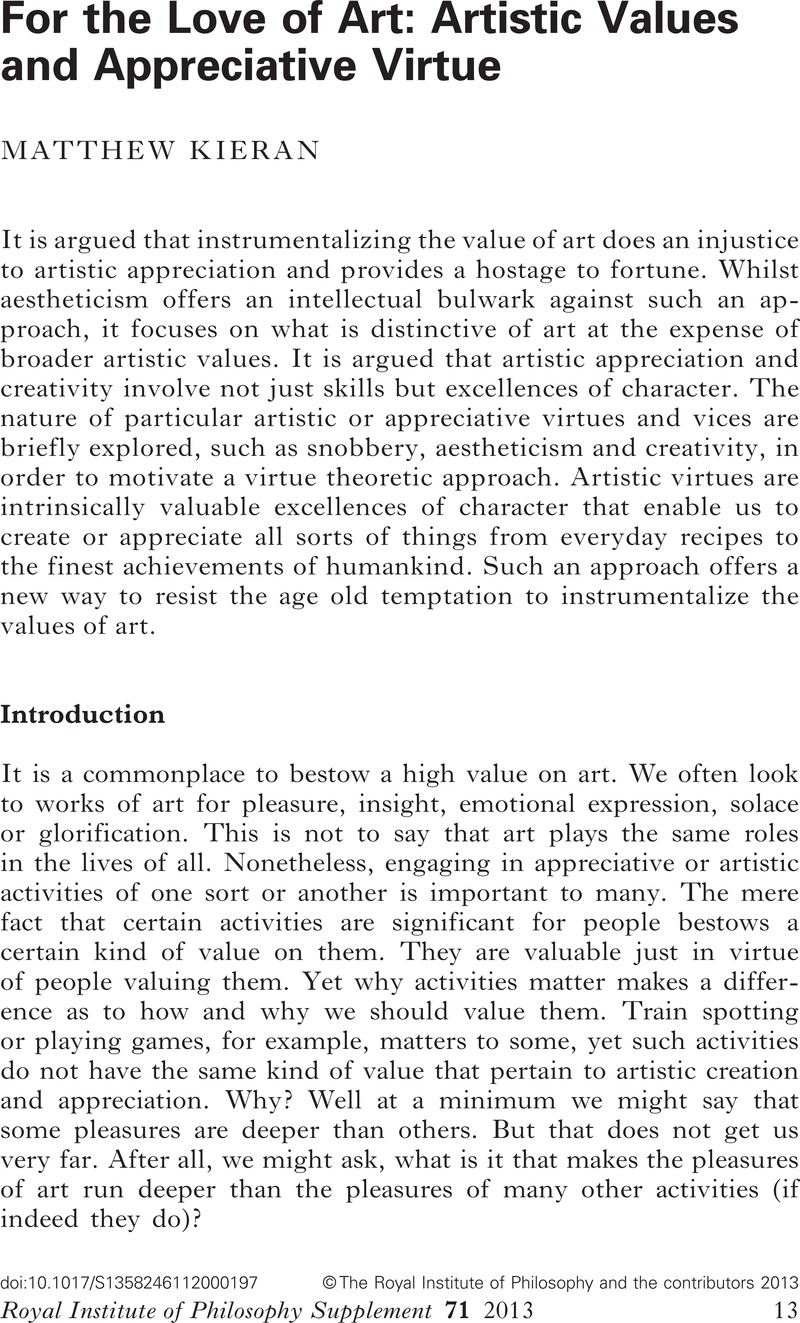Published online by Cambridge University Press: 11 March 2013

1 The U.K. Department for Culture, Media and Sport has consistently emphasized that the cultural and creative industries promote economic growth. See, for example, the DCMS report Staying Ahead: The Economic Performance of the U.K. Creative Industries (2007). The recent DCMS commissioned report by David O'Brien, Measuring the Value of Culture (2010) examines how the arts might adopt economic valuation techniques that mesh with H. M. Treasury (as is the case with health and the environment). This is far from a parochial concern. See, for example, the U.S.A's National Endowment for the Arts report Time and Money: Using Federal Data to Measure the Value of Performing Arts Activities (2011).
2 As spoken by the famous England cricket captain Douglas Jardine in Michael Pinchbeck's play The Ashes.
3 See Campbell, Don, The Mozart Effect (New York: William Morrow Harper Collins, 1997)Google Scholar and products such as The Mozart Effect – Music for Babies.
4 Rauscher, Frances H., Shaw, Gordon L. and Ky, Catherine N., ‘Music and Spatial Task Performance’, Nature 365 (14th October, 1993), 111CrossRefGoogle ScholarPubMed.
5 See Winner, Ellen and Hetland, Lois (eds.), ‘The Arts and Academic Achievement: What the Evidence Shows’, Journal of Aesthetic Education 34 (2000)Google Scholar.
6 Hume, David, ‘Of the Standard of Taste’, in his Selected Essays (Oxford: Oxford University Press, [1757]1993), 133–153Google Scholar.
7 Op. cit. note 7, 141.
8 Op. cit. note 7, 144.
9 This includes, for example, the art historical categories required to apprehend appreciatively relevant features such as a work's expressive and representational features. See Walton, Kendall, ‘Categories of Art’, Philosophical Review 79 (1970), 334–367CrossRefGoogle Scholar.
10 See Kieran, Matthew, ‘The Fragility of Aesthetic Knowledge: Aesthetic Psychology and Aesthetic Virtues’ in Goldie, Peter and Schellekens, Elisabeth (eds), The Aesthetic Mind: Philosophy and Psychology (Oxford: Oxford University Press, 2011)Google Scholar.
11 See, for example, Lamarque, Peter and Olsen, Stein, Truth, Fiction and Literature (Oxford: Oxford University Press, 1997)Google Scholar and Zangwill, Nick, ‘Moderate Aesthetic Formalism’, Philosophical Quarterly 50, 201, (2000), 476–493Google Scholar.
12 Beardsley, Monroe, Aesthetics: Problems in the Philosophy of Criticism (New York: Harcourt, Brace and World, 1958)Google Scholar.
13 Stolnitz, Jerome, ‘On the Cognitive Triviality of Art’, British Journal of Aesthetics, 32, 3 (1992), 191–200CrossRefGoogle Scholar.
14 See Kieran, Matthew, Revealing Art (London: Routledge, 2004), 138–147Google Scholar. The idea is that when Gombrich, Ernst, in Art and Illusion: A Study in the Psychology of Pictorial Representation (London: Phaidon, 1960)Google Scholar, focuses on appreciating visual schemas or Wood, James, in How Fiction Works (London: Jonathan Cape, 2008)Google Scholar, highlights fictional techniques which draw on seeing the world from another's point of view, we should think of these as the exercise of mental skills.
15 Orwell, George, 1984 (London: Penguin, [1949] 1989), 3Google Scholar.
16 See Gaut, Berys, ‘Art and Knowledge’ in Levinson, Jerrold (ed.), The Oxford Handbook of Aesthetics (Oxford: Oxford University Press, 2003), 436–450Google Scholar, and Kieran, Matthew, Revealing Art (London: Routledge, 2004), 148–204Google Scholar.
17 See Gaut, BerysArt, Emotion and Ethics (Oxford: Clarendon Press, 2007)Google Scholar for defence of this claim and Carroll, Noel, Beyond Aesthetics (Cambridge: Cambridge University Press, 2009)Google Scholar, Part IV, for inter-related essays defending a more moderate moralism.
18 See Kieran, Matthew, ‘Emotions, Art, and Immorality’ in Goldie, Peter (ed.), The Oxford Handbook of the Philosophy of Emotions (Oxford: Oxford University Press, 2010), 681–704Google Scholar.
19 Bertini, Marco, Ofek, Eliie and Ariely, Dan, ‘The Impact of Add-On Features on Consumer Product Evaluations’, Journal of Consumer Research, 36, 1, (2009), 17–28CrossRefGoogle Scholar.
20 Cutting, James, ‘Gustave Caillebotte, French impressionism, and mere exposure’, Psychonomic Bulletin and Review 10, 2 (2003), 319–343CrossRefGoogle ScholarPubMed.
21 See Hekkert, Paul and van Wieringen, Piet C. W., ‘The impact of level of expertise on the evaluation of original and altered versions of post-impressionistic paintings’ Acta Psycholoigica, 94, 2 (1996), 117–131Google Scholar, and Hann, Marco A., Dijkstra, S. Gerhard and Dijkstra, Peter T., ‘Expert judgement versus public opinion’, Journal of Cultural Economics 29, (2005), 59–78Google Scholar.
22 See Kieran, Matthew, ‘The Fragility of Aesthetic Knowledge: Aesthetic Psychology and Aesthetic Virtues’ in Goldie, Peter and Schellekens, Elisabeth (eds), The Aesthetic Mind: Philosophy and Psychology (Oxford: Oxford University Press, 2011)Google Scholar.
23 Kieran, Matthew, ‘The Vice of Snobbery: Aesthetic Knowledge, Justification and Virtue in Art Appreciation’. Philosophical Quarterly, 60, 239 (2010), 243–263Google Scholar. For more general virtue theoretic approaches see Woodruff, David M., ‘A Virtue Theory of Aesthetics’, Journal of Aesthetic Education, 35, 3, (2001), 23–36Google Scholar, Goldie, Peter, ‘Virtues of Art and Human Well-Being’, Aristotelian Society Supplementary Volume, 82, 1, 175–195Google Scholar, Lopes, Dominic McIver, ‘Virtues of Art: Good Taste’ Aristotelian Society Supplementary Volume, 82, 1, 197–211Google Scholar, and Goldie, Peter, ‘Virtues of Art’, Philosophy Compass 5, 10, (2010), 830–9Google Scholar.
24 See Chamorro-Premuzic, Tomas, Reimers, Stian, Hsu, Anne and Ahmetoglu, Gorkan, ‘Who art thou? Personality predictors of artistic preferences in a large U.K. sample: The importance of openness’, British Journal of Psychology, 100, 3 (2009), 501–516CrossRefGoogle Scholar.
25 For a more detailed elaboration see Kieran, Matthew, ‘Creativity as a Virtue of Character’ in Kaufman, Scott Barry and Paul, Elliot Samuel (eds), The Philosophy of Creativity (Oxford: Oxford University Press, forthcoming)Google Scholar.
26 Amabile, Teresa M. (1985), ‘Motivation and Creativity: Effects of Motivational Orientation on Creative Writers,’ Journal of Personality and Social Psychology, 48 (2): 393–99Google Scholar, and Collins, Mary Ann and Amabile, Teresa M. (1999), ‘Motivation and Creativity’, in Sternberg, R. (ed.), Handbook of Creativity (Cambridge: Cambridge University Press), 297–312Google Scholar.
27 This is a version of my inaugural professorial lecture for the University of Leeds, Friday 12th November, 2010, and a public lecture in London for the Royal Institute of Philosophy, Friday 3rd December, 2010. Grateful acknowledgement is made to both audiences, including family, friends and esteemed colleagues, as well as the U.K. Arts and Humanities Research Council for funding research related to some of this work as part of the ‘Method in Philosophical Aesthetics: The Challenge from the Sciences’ project.